As the rover ascends, it moves along the Martian timeline, allowing scientists to study how Mars evolved from a planet that was more like Earth in the distant past, with a warmer climate and abundant water, to the icy desert it is today. The amount of frost on Mars’ equatorial volcanoes represents about 150,000 tons of water exchanged between the surface and the atmosphere every day during the cold season, equivalent to about 60 Olympic swimming pools. NASA’s Curiosity rover has discovered crystals of pure sulfur on Mars.
NASA’s Curiosity rover has discovered crystals of pure sulfur on Mars, the US space agency reported. “For the first time, a rover has discovered crystals of pure sulfur on the Red Planet,” NASA reported on social media. The discovery was made back in May, when scientists saw a rock split by the rover that turned out to be bright yellow inside.
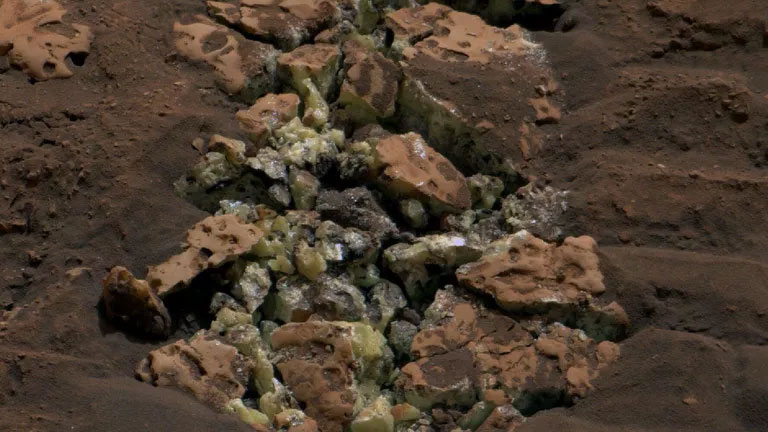
Crystals of pure sulfur on Mars discovered by NASA’s Curiosity rover
NASA clarified that although the presence of sulfur-containing minerals on Mars has long been known, this is the first time it has been discovered in its pure form. As NASA noted, “pure sulfur only forms under specific conditions that scientists did not associate with the history of the place where it was found.” “Finding a whole field of rocks made of pure sulfur is like finding an oasis in the desert, now we have to explain it,” said Ashwin Vasavada, a research scientist on the Curiosity mission, in connection with the discovery.
Other discoveries made by the rover include wavy textures in rocks, indicating that lakes existed in a region of ancient Mars that scientists expected to be drier.
When NASA’s Curiosity rover arrived at the “sulfate-bearing unit” last fall, scientists thought they had seen the final evidence that lakes once covered this region of Mars. That’s because the rock layers there formed in drier conditions than regions previously explored by the mission. The area’s sulfates — salty minerals — are thought to have been left behind when the water dried to a trickle.
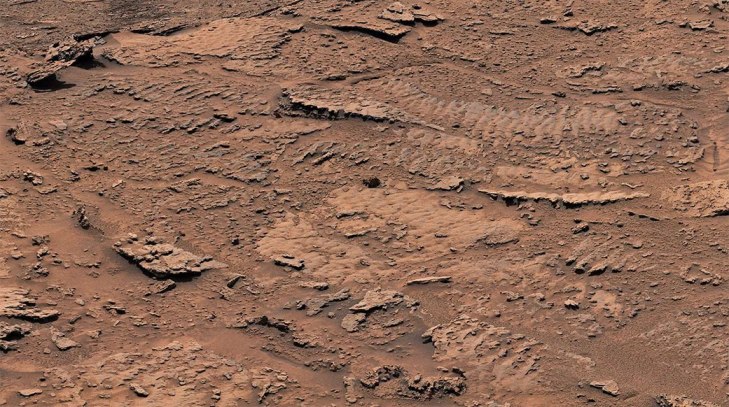
Billions of years ago, waves on the surface of a shallow lake stirred up sediment at the bottom of the lake. Over time, the sediment formed into rocks with a wavy texture that are the clearest evidence of waves and water that NASA’s Curiosity rover has ever found. NASA/JPL-Caltech/MSSS
So the Curiosity team was surprised to find the mission’s clearest evidence yet of ancient water ripples that formed inside lakes. Billions of years ago, waves on the surface of a shallow lake stirred up sediment at the bottom of the lake, eventually creating rippled textures that are etched into the rocks.
“This is the best evidence of water and waves that we’ve seen so far on the mission,” said Ashwin Vasavada, Curiosity’s project scientist at NASA’s Jet Propulsion Laboratory in Southern California. “We’ve waded through thousands of feet of lake sediment and never seen evidence like this — and now we’ve found it in a place we thought would be dry.”

At the bottom of this valley, called Gediz Vallis, is a mound of boulders and debris thought to have been carried there by wet landslides billions of years ago. The rover team hopes to get a closer look at this evidence of flowing water, which is likely the youngest Curiosity has ever found. NASA/JPL-Caltech/MSSS
Since 2014, the rover has been climbing to the base of Mount Sharp, a 3-mile (5-kilometer) high mountain that was once dotted with lakes and streams that could have provided a hospitable environment for microbial life if it ever formed on the Red Planet.
Mount Sharp is made up of layers, with the oldest at the base of the mountain and the youngest at the top. As the rover climbs, it moves along the Martian timeline, allowing scientists to study how Mars evolved from a planet that was more like Earth in the distant past, with a warmer climate and plenty of water, to the icy wasteland it is today.
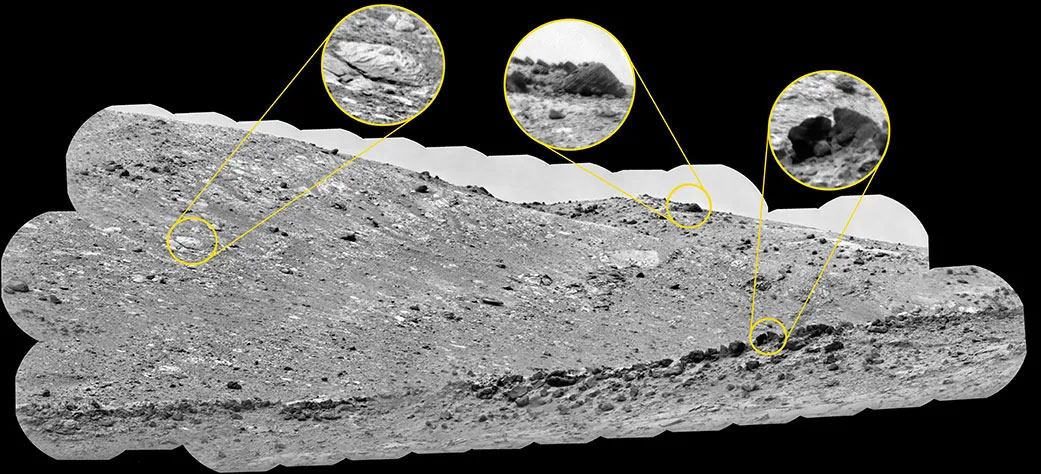
Curiosity used its ChemCam instrument to look at the Gediz Valley ridge, finding boulders that are thought to have been washed down by an ancient mudflow. One reason scientists are interested in the ridge is that it includes boulders that originated much higher up on Mount Sharp, where Curiosity won’t be able to reach. NASA/JPL-Caltech/LANL/CNES/CNRS/IRAP/IAS/LPG
Rising nearly half a mile above the base of the mountain, Curiosity found these rippled rock textures preserved in what’s known as the “Marker Band,” a thin layer of dark rock that stands out from the rest of Mount Sharp. The rock is so hard that Curiosity has been unable to drill a sample out of it, despite several attempts.
Another clue in the Marker Band that fascinated the team was the unusual texture of the rock, likely caused by some kind of regular weather or climate cycle, such as dust storms. Not far from the wavy textures are rocks made up of layers that are regularly spaced and thick. This kind of rhythmic pattern in rock layers on Earth is often caused by atmospheric events that occur at regular intervals. It’s possible that the rhythmic patterns in these Martian rocks were caused by similar events, indicating changes in the Red Planet’s ancient climate.
“Ripples, debris flows, and rhythmic layers all tell us that the history of the transition from wet to dry on Mars was not simple,” Vasavada said. “The ancient climate of Mars had a remarkable complexity, much like Earth’s.”
ESA’s ExoMars and Mars Express missions have discovered water ice for the first time near the equator of Mars, a part of the planet where ice was thought to be impossible.
Frost covers the summits of the Tharsis volcanoes: the highest volcanoes not only on Mars but in the Solar System. It was first seen by ESA’s ExoMars Trace Gas Orbiter (TGO), and then by another instrument on board TGO and ESA’s Mars Express.
“We thought that frost formation near the equator of Mars was impossible because the combination of sunlight and the thin atmosphere keeps both the surface and the mountain tops relatively warm – unlike what we see on Earth, where you would expect to see frost-covered peaks,” says lead author Adomas Valantinas, who made the discovery as a PhD student at the University of Bern in Switzerland and is now a research fellow at Brown University in the US.
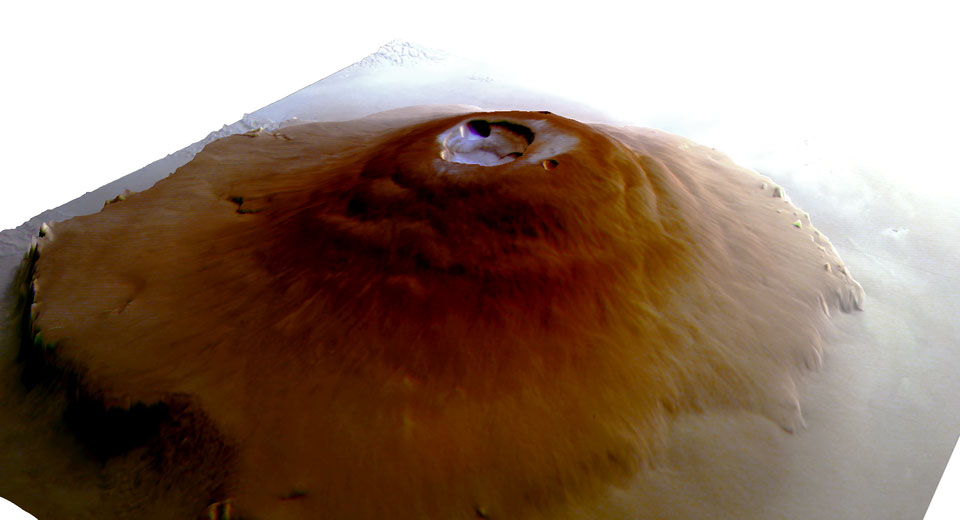
Perspective view of Olympus Mons from Mars Express, with frost (blue) in the cauldron-shaped depression. ESA
“Its existence here is fascinating and suggests that there are exceptional processes at work here that allow frost to form.”
The frost patches are present for a few hours around sunrise before they evaporate under the influence of sunlight. Although they are thin – probably only a hundredth of a millimetre thick (about the thickness of a human hair) – they cover a huge area. The amount of frost represents about 150,000 tons of water exchanged between the surface and the atmosphere every day during the cold season, the equivalent of about 60 Olympic swimming pools.
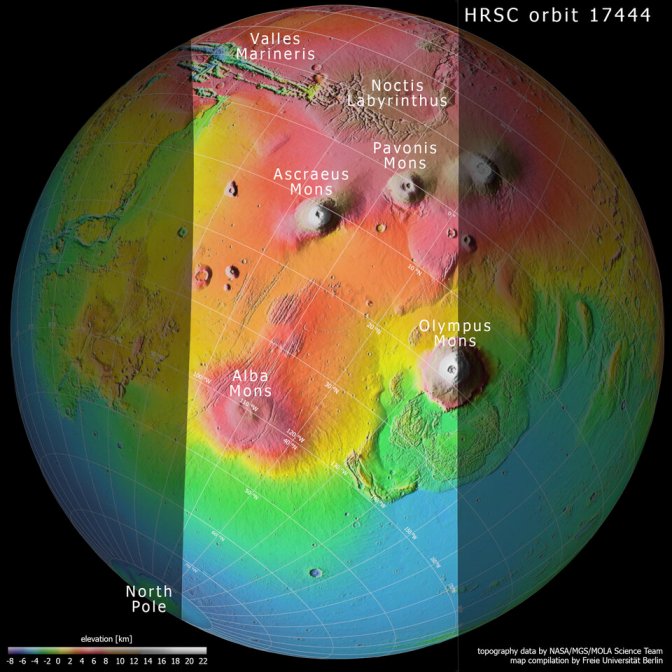
Topography of the Tharsis region on Mars. ESA
The Tharsis region of Mars contains many volcanoes, including Olympus Mons and the Tharsis Mons: Ascraeus, Pavonis, and Arsia. Many of these volcanoes are colossal, rising above the surrounding plains to heights ranging from one (Pavonis) to three (Olympus Mons) times that of Earth’s Mount Everest.
These volcanoes have calderas, large depressions, at their summits caused by the emptying of magma chambers during past eruptions. Researchers speculate that air circulates in a special way over Tharsis; this creates a unique microclimate in the volcanoes’ calderas, allowing frost patches to form.
“Winds rise up the mountain slopes, transporting relatively moist air from the surface to higher altitudes, where it condenses and settles as frost,” says co-author Nicholas Thomas, principal investigator of TGO’s Color and Stereo Surface Imaging System (CaSSIS) and Adomas’ PhD supervisor at the University of Bern. “We actually see this happening on Earth and other parts of Mars, with the same phenomenon being caused by the seasonal Martian elongated cloud Arsia Mons.”

Frost on Olympus Mons as seen from Mars Express. ESA
“The frost we see on the tops of Martian volcanoes appears to settle in the shadowed areas of the calderas where temperatures are cooler.”
Adomas, Nicholas and colleagues have spotted frost on the volcanoes Olympus Tharsis, Arsia and Askreas, as well as on the Ceraunian dome. Modeling how these frosts form could allow scientists to unlock more of Mars’s remaining secrets, including where water is located and how it moves between reservoirs, as well as understand the complex dynamics of the planet’s atmosphere. Such knowledge is essential for our future exploration of Mars and the search for possible signs of life beyond Earth.
The discovery marks the first time frost has been detected on Mars’ equator. But why hasn’t it been spotted before?
“There are several reasons: firstly, we need an orbit that will allow us to observe the site in the early morning. While two of ESA’s Mars orbiters, Mars Express and TGO, have such orbits and can observe at any time of day, many of the other agencies’ spacecraft are instead synchronized with the Sun and can only observe during the day,” adds Adomas.
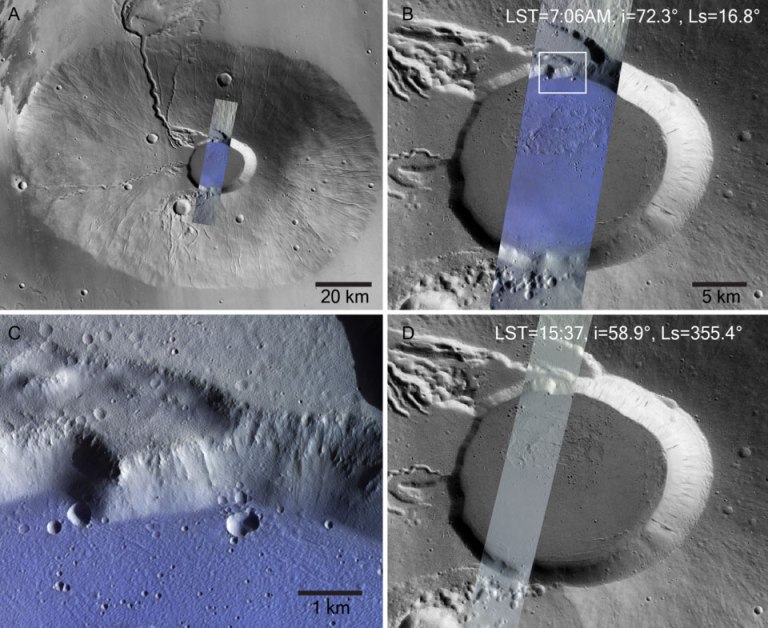
ExoMars detects frost on Ceraunius Tholus. ESA
“Secondly, frost deposition is associated with colder Martian seasons, which further narrows the window for its detection. In short, we need to know where and when to look for ephemeral frost. We were looking for it near the equator for some other study, but we didn’t expect to see it on the tops of Mars volcanoes!”
The detection of frost was made possible by the collaboration of two ESA orbiters exploring Mars: ExoMars TGO and Mars Express.
TGO arrived at Mars in 2016 and has been imaging and mapping the surface, atmosphere, and water of Mars since the start of its full science mission in 2018. Mars Express has been in orbit around Mars since 2003 and has spent two decades exploring the surface, subsurface, minerals, phenomena, and atmosphere of Mars.
The research team discovered the frost using TGO’s CaSSIS instrument. They then confirmed their discovery by re-examining the area using TGO’s Nadir and Occultation Spectrometer for Mars Discovery (NOMAD) and Mars Express’ High Resolution Stereo Camera (HRSC).
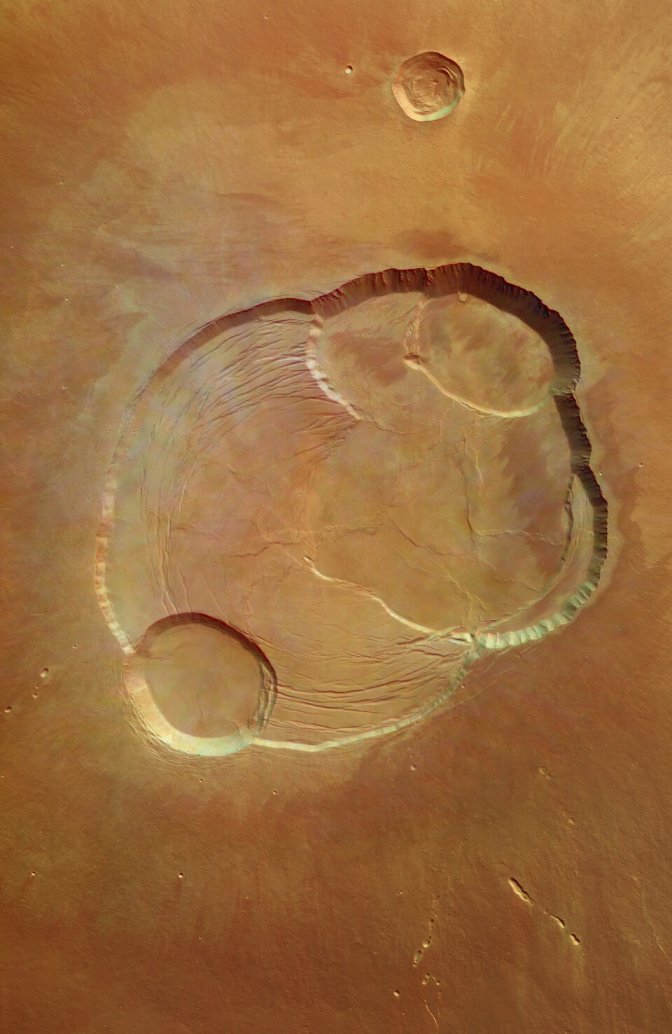
Olympus Mons as seen by Mars Express in 2004. ESA
“Finding water on the surface of Mars is always exciting, both for the scientific interest and for its implications for human and robotic exploration,” says Colin Wilson, ESA Project Scientist for ExoMars TGO and Mars Express. “However, this discovery is particularly exciting. Mars’ low atmospheric pressure creates an unusual situation where the planet’s mountaintops are usually no colder than its plains, but it appears that moist air rising up the mountain slopes can still condense into frost, a distinctly Earth-like phenomenon.
“This discovery was made possible by the successful collaboration between both ESA Mars orbiters and complementary modelling. Understanding exactly which phenomena are the same or different on Earth and Mars really tests and improves our understanding of fundamental processes that occur not only on our home planet but elsewhere in space.”
An international team of planetologists has discovered in seismic data collected by the American InSight landing platform that the frequency of cratering on Mars may have increased in the last few decades by 2 to 10 times compared to past geological eras. The scientists’ findings were published in an article in the scientific journal Science Advances.
“Our seismic observations of cratering on Mars suggest that the frequency of cratering may be significantly higher than that indicated by satellite imagery of the planet’s surface. The difference between these estimates ranges from 2 to 10 times, depending on the diameter of the craters. This increase in cratering potentially indicates that the frequency of asteroid and meteorite impacts on Mars has increased significantly,” the researchers write.
That’s the conclusion reached by a team led by Bruce Banerdt, the principal investigator for NASA’s InSight mission, which monitored Marsquakes for three years before the lander’s demise in December 2022 as a result of a dust storm and sand accumulation on its solar panels. Many of the Martian surface tremors InSight recorded were recently discovered to be caused by asteroid and meteorite impacts.
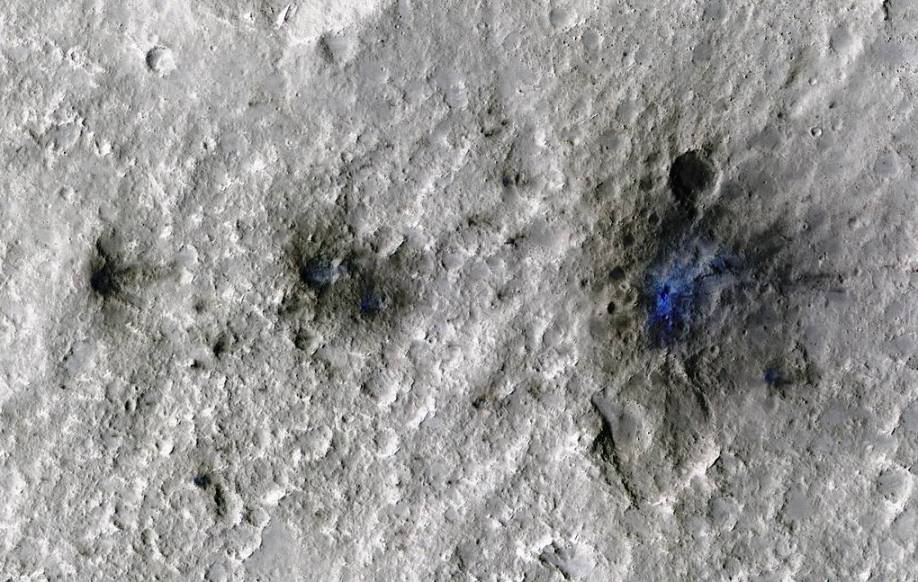
NASA/JPL-Caltech/University of Arizona
Scientists used this to estimate how often such cataclysms occur. To do this, scientists studied images of the Martian surface obtained by the CTX camera on board the MRO probe between 2006 and 2021, counted the number of new craters and compared them with how often the InSight mission seismometer recorded asteroid impacts.
When planetologists compared these estimates, they found that the frequency of crater formation on Mars in recent years greatly exceeded this indicator for the previous decade, as well as past geological eras. In particular, small craters up to 10 m in diameter are forming an order of magnitude more often in the current years, while large traces of asteroid impacts, whose sizes exceed 100 m, began to appear twice as often.
Scientists suggest that the increased frequency of crater formation may be due to the fact that a large asteroid may have recently broken up in the immediate vicinity of Mars, whose debris is now periodically falling on the fourth planet of the Solar System. In particular, this is supported by the fact that InSight, with a gap of only 97 days, recorded tremors caused by the formation of two large craters at once, whose diameter exceeds 100 m. Subsequent observations and measurements will show whether this is actually the case, planetologists concluded.
The InSight lander landed on the surface of Mars in December 2018 to search for marsquakes and study the planet’s internal structure. In the first six months of operation, it recorded several hundred marsquakes, which helped scientists determine the size of Mars’ core, as well as its crust and mantle, and identify possible traces of liquid magma in the mantle of the fourth planet in the solar system.
“Global” dust storms, where a series of uncontrolled storms create a dust cloud large enough to envelop Mars, only occur once every six to eight years (that’s three to four Martian years). Scientists still don’t understand why or how exactly these storms form and evolve.
In June, one such dust event quickly engulfed the planet. Scientists first observed a smaller dust storm on May 30. By June 20, it had become global.
For the Opportunity rover, this meant a sharp drop in visibility from a clear sunny day to an overcast one. Since Opportunity runs on solar power, scientists had to suspend science activities to conserve the rover’s batteries. As of July 18, there had been no response from the rover.
Fortunately, all that dust acts as an atmospheric insulator, keeping nighttime temperatures from dropping below what Opportunity can handle, and it could be weeks or even months before the dust begins to settle. Based on the length of the 2001 global storm, NASA scientists estimate that the haze will clear enough for Opportunity to power up and return home by September.
As the skies begin to clear, Opportunity’s solar panels may be covered in a thin film of dust. This could delay the rover’s recovery while it collects energy to recharge its batteries. A gust of wind could help, but is not necessary for a full recovery.
While the Opportunity team eagerly awaits news from the rover, scientists on other Mars missions have had a rare opportunity to study this puzzle.
The Mars Reconnaissance Orbiter, Mars Odyssey, and Mars Atmosphere and Volatile EvolutioN (MAVEN) orbiters are all adapting their observations of the Red Planet to study this global storm and learn more about Martian weather patterns. Meanwhile, the Curiosity rover is studying the dust storm from the surface of Mars.
Each orbiter is currently studying the dust storm:
Using the THEMIS (Thermal Emission Imaging System) instrument, scientists can track the surface temperature of Mars, the temperature of the atmosphere, and the amount of dust in the atmosphere. This allows them to observe how a dust storm grows, evolves, and dissipates over time.
“This is one of the largest weather events we’ve seen on Mars,” said Michael Smith, a scientist at NASA’s Goddard Space Flight Center in Greenbelt, Maryland, who works on the THEMIS instrument. “Having another example of a dust storm really helps us understand what’s going on.”
Since the dust storm began, the THEMIS team has increased the frequency of global atmospheric observations from every 10 days to twice a week, Smith said. One mystery they’re still trying to solve: how these dust storms become global. “Every Martian year, during the dust season, there are many local or regional storms that cover one area of the planet.” But scientists aren’t yet sure how these small storms sometimes grow to cover the entire planet.
Mars Reconnaissance Orbiter (MRO). MRO has two instruments studying the dust storm. Each day, the Mars Color Imager (MARCI) maps the entire planet in the middle of the day to track the storm’s progress. Meanwhile, MRO’s Mars Climate Sounder (MCS) measures how atmospheric temperature changes with altitude. Since late May, the instruments have been monitoring the start and rapid expansion of a dust storm on Mars.
Using this data, scientists are studying how the dust storm changes the temperature of the planet’s atmosphere. As in Earth’s atmosphere, changing temperatures on Mars can affect winds and even the circulation of the entire atmosphere. This provides a powerful feedback loop: solar heating of dust lifted into the atmosphere changes the temperature, which changes the winds, which can make the storm stronger, lifting more dust from the surface.
Scientists want to learn the details of the storm — where is the air rising or falling? How does the atmosphere’s temperature now compare to a year without storms? And, as with Mars Odyssey, the MRO team wants to learn how these dust storms become global.
“The fact that you can start with something that’s a local storm, no bigger than a small [U.S.] state, and then have something that kicks up more dust and creates a haze that covers almost the entire planet is remarkable,” said Rich Zurek, MRO project scientist.
Scientists want to figure out why these storms happen every few years, which is hard to do without a long history of such events. It’s as if aliens were watching Earth and observing the climate effects of El Niño over many years of observations. They would wonder why some regions get more rain and others get more drought, seemingly with some regularity.
“Ever since the MAVEN orbiter entered Mars orbit, one of the things we’ve been waiting for is a global dust storm,” said Bruce Jakosky, principal investigator for the MAVEN orbiter.
But MAVEN isn’t studying the dust storm itself. Instead, the MAVEN team wants to study how the dust storm affects Mars’s upper atmosphere, more than 100 kilometers above the surface, where dust doesn’t even reach. MAVEN’s mission is to figure out what happened to Mars’s early atmosphere. We know that at some point billions of years ago, liquid water pooled and flowed across Mars’ surface, meaning its atmosphere must have been denser and more insulating, like Earth’s. Since MAVEN arrived at Mars in 2014, its research has shown that that atmosphere may have been stripped away by the solar wind’s outflow over the course of a few hundred million years, between 3.5 and 4.0 billion years ago.
But there are still nuances to figure out, such as how dust storms like the current one affect how atmospheric molecules escape into space, Jakosky said. For example, a dust storm acts as an atmospheric insulator, trapping heat from the sun. Does that warming change the way molecules escape from the atmosphere? It’s also likely that as the atmosphere warms, more water vapor rises high enough to be broken down by sunlight, and the solar wind carries hydrogen atoms into space, Jakosky said.
Most NASA spacecraft study the dust storm from above. The Mars Science Laboratory’s Curiosity rover has a unique perspective: The nuclear-powered science vehicle is largely immune to dark skies, allowing it to collect scientific data from beneath the beige veil that shrouds the planet.
“We’re doing double duty right now,” said Ashwin Vasavada of JPL, Curiosity’s project scientist. “Our newly commissioned drill is getting a fresh rock sample. But we’re also using instruments to study how the dust storm is developing.”
Curiosity has several “eyes” that can determine the abundance and size of dust particles based on how they scatter and absorb light. This includes its Mastcam, ChemCam, and the ultraviolet sensor on REMS, its suite of meteorological instruments. REMS can also help study atmospheric tides — changes in pressure that move in waves throughout the planet’s thin air. These tides vary dramatically depending on where the dust is located globally, not just inside Gale Crater.
The global storm could also reveal secrets about Martian dust devils and winds. Dust devils can form when the planet’s surface is hotter than the air above it. The heat creates swirls of air, some of which pick up dust and become dust devils. During a dust storm, there is less direct sunlight and cooler daytime temperatures; this could mean fewer devils swirling above the surface.
Even new drilling could advance the science of dust storms: Watching the small clumps of loose material created by Curiosity’s drilling is the best way to monitor the winds.
Scientists expect the dust storm to last for at least a couple of months. Every time you see Mars in the sky in the coming weeks, remember how much data scientists are collecting to better understand the Red Planet’s mysterious weather.
The centerpiece of this new image from the European Space Agency’s Mars Express spacecraft is an intriguing feature: a dark, jagged scar cutting through the marble surface at the base of a giant volcano.
This scar, known as the Aganippe Fossa, is a roughly 600-km-long irregular structure known as a ‘graben’: a trench-like groove with steep walls on either side.
Fossa Aganippe crosses the lower flank of one of Mars’ largest volcanoes, Arsia Mons. Mars Express regularly observes Arsia Mons and its nearby moons in the Tharsis region, home to several of Mars’s giant volcanoes. This includes Olympus Mons, the tallest volcano in the solar system (visible in the context map associated with this new image, along with Arsia Mons).
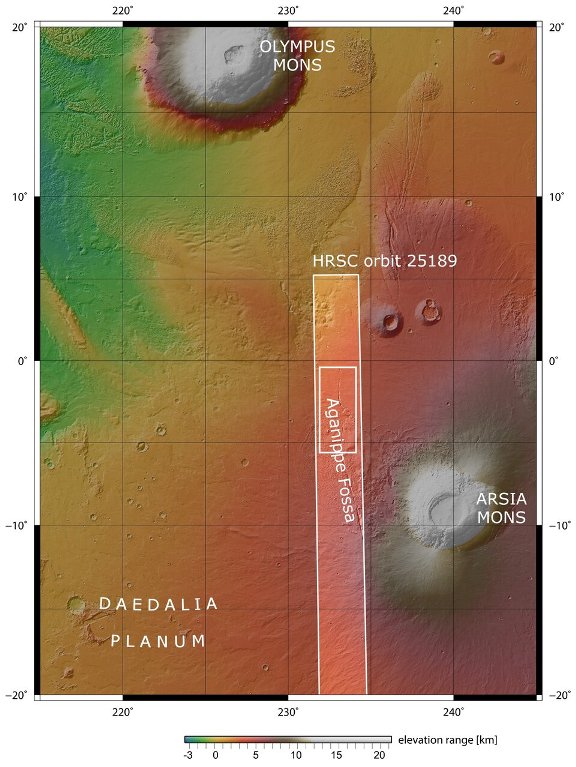
A wider view of the Aganippe fossa
Mount Arsia itself is 435 km in diameter and rises more than 9 km above the surrounding plains. By comparison, the tallest dormant volcano on Earth, Ojos del Salado on the border of Argentina and Chile, reaches a height of less than 7 km.
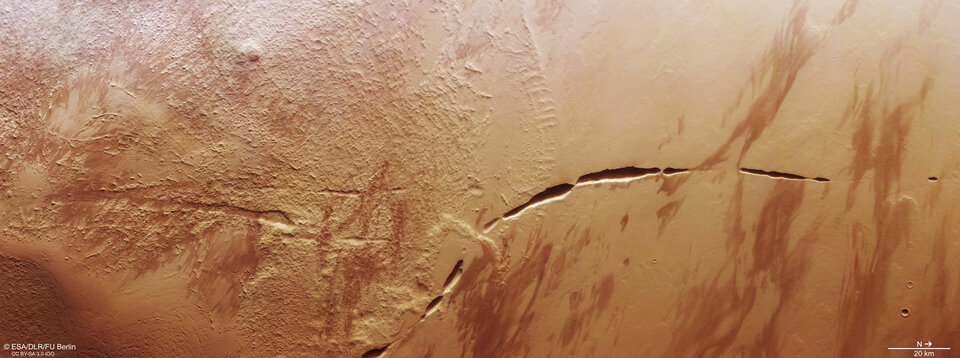
A winding scar on Mars
We still don’t know for sure how or when the Aganippe Pit formed, but it’s likely that it formed when magma rising beneath the enormous mass of the Tharsis volcanoes caused the crust of Mars to stretch and crack.
ExoMars orbiter snaps close-up of huge crater on Mars. A huge impact crater on Mars dominates a new image from the ExoMars Trace Gas Orbiter (TGO).
The crater, formed by the impact of an ancient asteroid, is located on Mars’ Utopia Planitia. It is the largest known impact basin in the entire solar system, with a diameter of about 2,050 miles (3,300 kilometers), twice the size of Earth’s Sahara Desert from north to south. The European Space Agency (ESA) said the crater’s intriguing ice formations on and beneath the surface provide clues to the Red Planet’s watery past.
“This remnant of an ancient impact is just one of many scars that asteroids have left on the Red Planet,” ESA officials said in a statement. “Water, volcanoes and asteroid impacts have shaped the Martian surface in the distant past. Mars is now a cold, dry desert.”
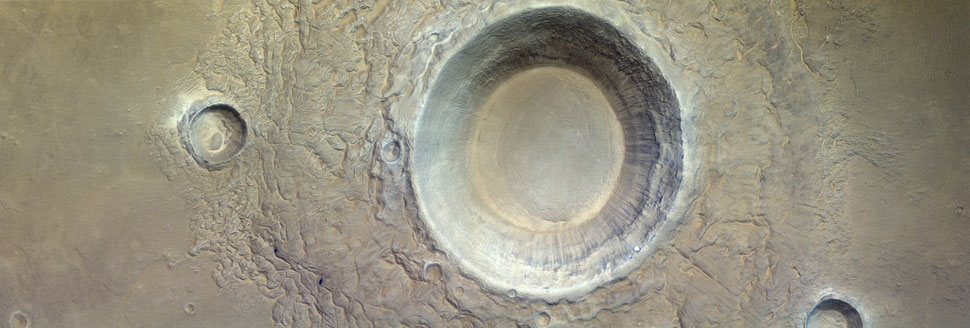
A panoramic view of the Utopia Planitia region of Mars with a huge impact crater, taken by the ExoMars Trace Gas Orbiter (TGO). ESA/TGO/CaSSIS)
The recent image was taken by ExoMars’s CaSSIS (Colour and Stereo Surface Imaging System) instrument from just 248 miles (400 km) above the crater. From this vantage point, the crater nearly fills the camera’s field of view. On May 15, ESA shared a new panoramic image centered on the crater.
The Utopia Planitia region is known to exhibit icy features, including frost on the surface during the Martian winter. The crater, which is about 5 miles (8 km) across, also shows signs of material being ejected in a way that suggests there was water ice there when the asteroid slammed into the region in the distant past. The enormous heat released by the impact would have melted the water ice and pushed the resulting mixture of liquid water and dust upward.
“The smooth appearance of the crater is consistent with other features in the region that show evidence of a history of water-ice environments,” ESA officials said. “Closing closer to the crater reveals striations on its walls, evidence of landslides, and ripples created by wind.”
In addition to taking stunning photos like this one, the orbiter is studying the planet’s atmospheric gases and mapping the surface of Mars for water-rich areas. In turn, this data could be used to better understand the history of water on Mars and the possible existence of ancient life.
Adventures of the Curiosity rover. The visit to Pinnacle Ridge provided an opportunity to learn more about the materials that make up the ridge and the role of water in this area.

This image was taken by the left navigation camera on NASA’s Curiosity rover on Sol 4180 (May 10, 2024, 03:55:37 UTC). NASA/JPL-Caltech
Sol 1151-1152: The local rocks were examined more closely with the instruments. The abrasion of Old Faithful Geyser revealed a fresh, clean rock surface, unobstructed by dust or rock coatings. Since the last abrasion at the Bunsen Peak work site, almost 1 km to the east, the team has been working hard to understand the potential textural and compositional variability within the boundary unit, which may provide important information about the geologic history of these rocks.
Remote science observations of nearby cliffs using the SuperCam and Mastcam-Z instruments. Mastcam-Z was also used to obtain images from a greater distance, looking east down into the Neretva Valley, an ancient river valley carved by water more than 3 billion years ago. After completing its survey of the abrasion site, Perseverance headed a short distance northwest to a high point called Overlook Mountain.
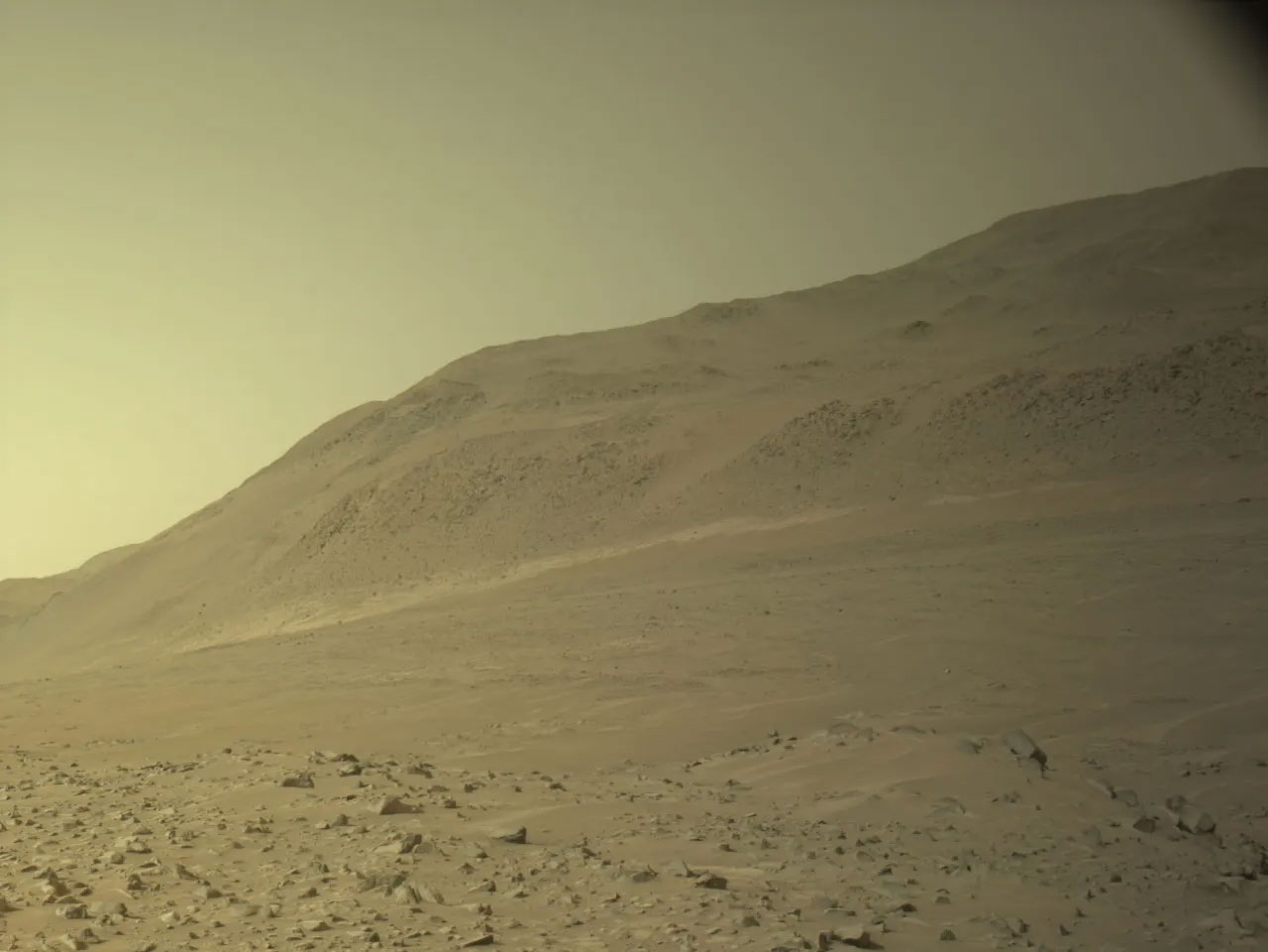
Mars Perseverance Sol 1150 — Left navigation camera: Perseverance’s daytime view looking northwest. The rocky terrain in the foreground is part of a boundary block. Beyond it lies Nereteva Vallis, an ancient river channel. NASA/JPL-Caltech
Stunning views from Mount Sharp. Another area of the Pinnacle Ridge site at Gediz Vallis was imaged to continue documenting the textures and structures associated with this relatively young feature in Gale Crater. A number of environmental and atmospheric monitoring observations were also made. These included Navcam dust devil and over-the-horizon movies, line-of-sight scanning, and deck monitoring. Standard DAN and RAD completed the busy schedule.
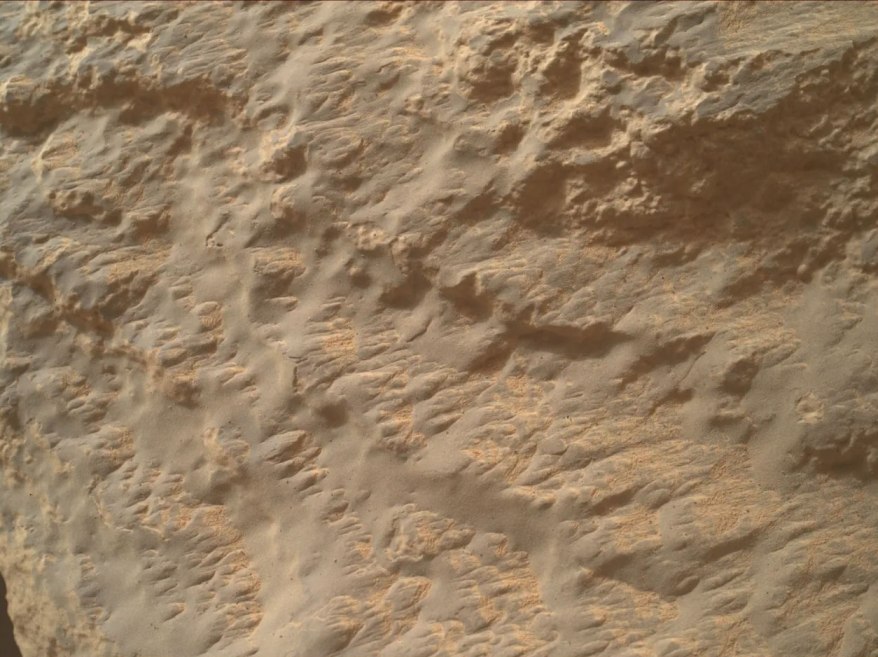
NASA’s Curiosity rover captured this image using its Mars Hand Lens Imager (MAHLI), located on a turret at the end of the rover’s robotic arm, on May 14, 2024, sol 4184 of the Mars Science Laboratory mission, at 06:58:35 UTC. NASA/JPL-Caltech/MSSS
Upon arrival at Bright Angel, Perseverance discovered unusual popcorn-like textures. Specifically, these rocks contain many veins and nodules. Veins are linear features containing mineral crystals that often form thin plates or sheets that cut through the rocks and intersect other veins. Veins are often more resistant to erosion than the rocks they are in, so they appear as raised surfaces. Nodules are small, rounded protrusions in the rocks. Nodules are often sites of mineral formation that are distinct from the surrounding rock.
Veins and nodules form when water flows through rock and minerals crystallize from that water in cracks and voids within the rock. Similar features have been observed previously by Perseverance during its exploration of western fan sediments, particularly during the Fan Front Campaign at Hogwallow Flats. However, these features were rare in the marginal portion.

NASA’s Mars Perseverance rover captured this image using its right-hand camera, Mastcam-Z. Mastcam-Z is a pair of cameras mounted high on the rover’s mast. This image was captured on June 10, 2024 (sol 1175, or Martian day 1175, of the Mars 2020 mission) at 14:04:57 local mean solar time. NASA/JPL-Caltech/ASU
“Loch Leven” is an example of the gray material that frames the Mammoth Lakes drill block. The remote imaging capabilities of the ChemCam tool will also be used to mosaic the nearby area with interesting lighter and darker areas in the outcrop. Mastcam (for color photos and video) will document the ChemCam target “Loch Leven” and film the Mammoth Lakes 2 borehole and surrounding sediments to track any changes caused by wind.
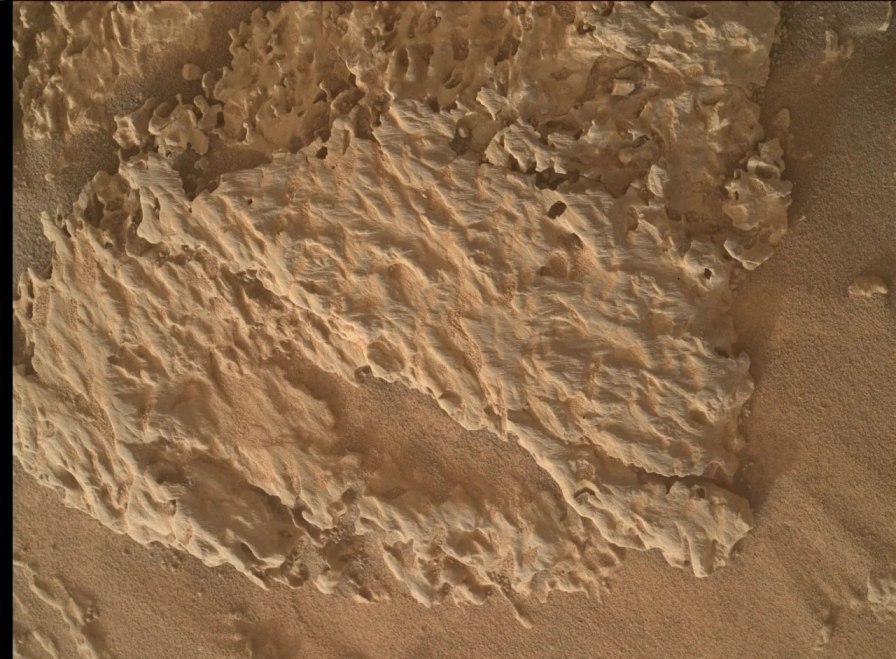
NASA’s Curiosity rover took this image about 10 inches (25 centimeters) from its Loch Leven target using its Mars Hand Lens Imager (MAHLI), a camera mounted on a turret at the end of the rover’s robotic arm, in daylight on June 16, 2024, Sol 4216 (or Martian day 4216) of the Mars Science Laboratory mission at 05:12:12 UTC. NASA/JPL-Caltech/MSSS
Sol 4225: Horsetail Falls Rappelling The Navcam image below shows the rough surface of Horsetail Falls as a band of dark, gravelly material near the top just right of the center edge of the light-colored Whitebark Pass slab. Horsetail Falls is an example of the variety of bedrock textures. This target is named for the famous 270-foot waterfall that flows out of Agnew Lake and is easily visible from the June Lake Loop.
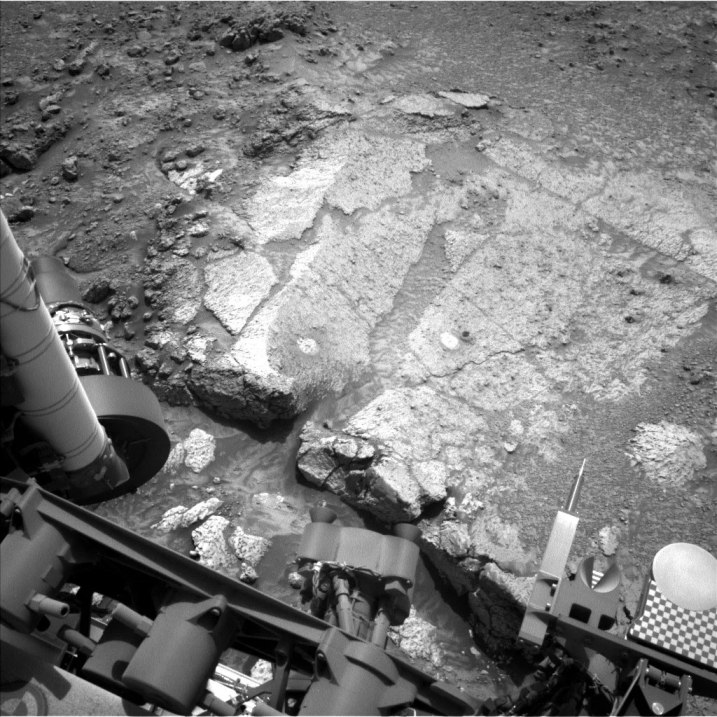
This image was taken by the left navigation camera aboard NASA’s Curiosity rover on Sol 4219 (2024-06-19 02:21:53 UTC). NASA/JPL-Caltech
The Mammoth Lakes 2 drilling attempt was a success. The actual drilling is just the beginning. The process uses a laser beam spectrometer (LIBS) to inspect the drilled hole before delivering some of the drilled material to CheMin (the Chemistry and Mineralogy X-ray Diffraction Instrument) for its own testing.
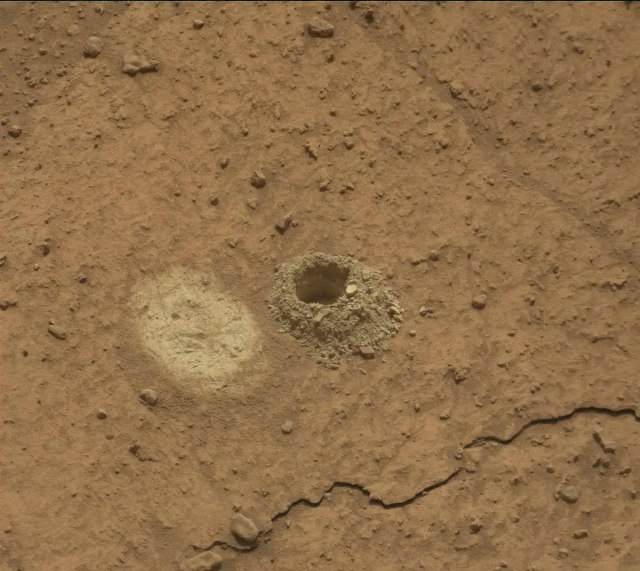
This image was taken by the Mast Camera (Mastcam) onboard NASA’s Curiosity rover on Mars day 4219 (June 19, 2024, 02:22:26 UTC). NASA/JPL-Caltech/MSSS
Curiosity then successfully advanced about 11 meters (about 36 feet) after a 27-sol drilling campaign in Mammoth Lakes to learn as much as possible about the colorful rocks with mysterious origins and an abundance of vugs (a geological term for cavities in the rock).
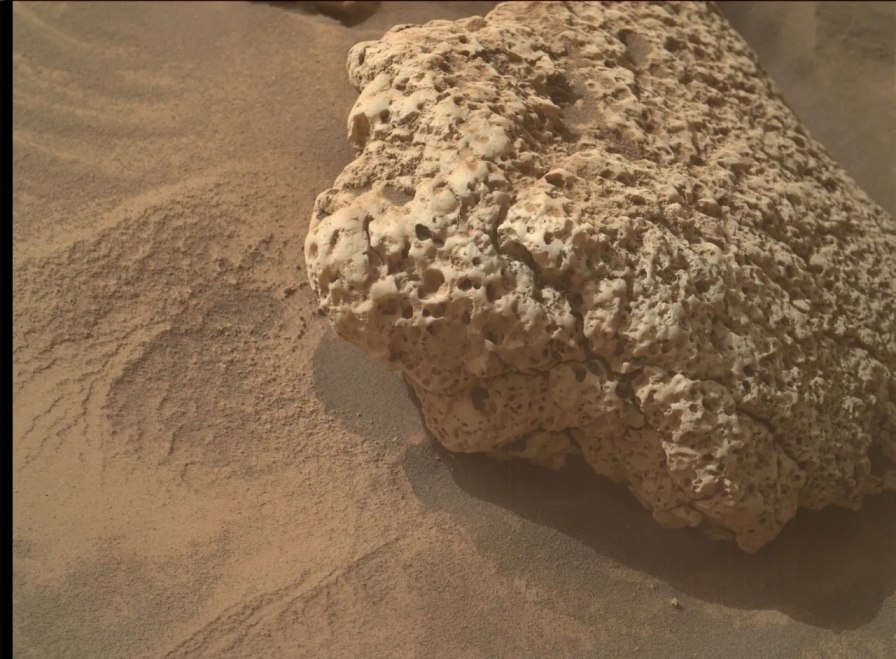
NASA’s Curiosity rover captured this image of a target called Glacier Notch on July 6, 2024, sol 4236 of the Mars Science Laboratory mission, at 16:55:06 UTC. Curiosity used its Mars Hand Lens Imager (MAHLI), located on a turret at the end of the rover’s robotic arm, to take the image from a distance of 32 centimeters (about 13 inches). NASA/JPL-Caltech/MSSS
The rover zeroed in on a very interesting outcrop of conglomerate rocks, which are made up of pebbles cemented by fine-grained matrix material. On Earth, conglomerate rocks are associated with downwellings of rock and soil mixtures, often in water-rich environments. The local outcrop of this unusual Martian deposit has been named Stubblefield Canyon after the headwaters of the creek that forms Rancheria Falls, which flows into Hetch Hetchy Reservoir in Yosemite National Park.
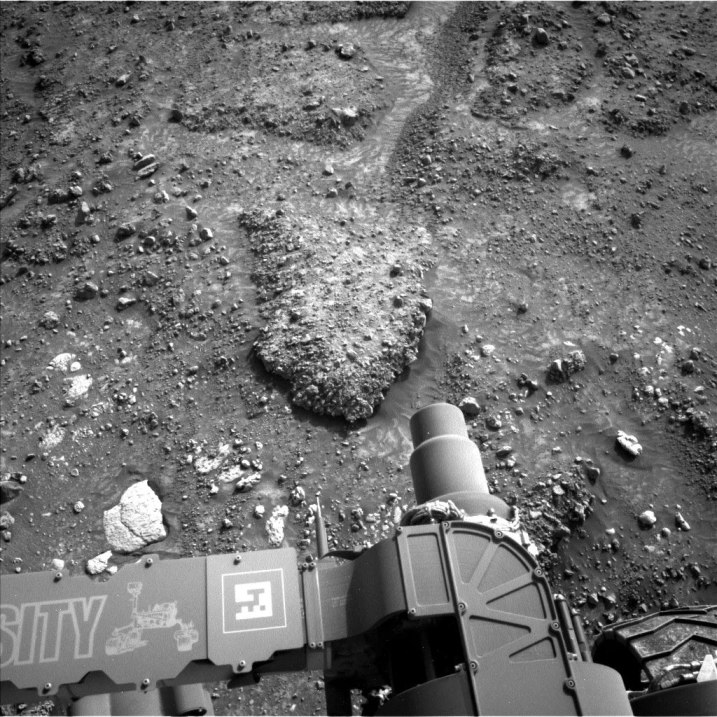
This image was taken by the left navigation camera aboard NASA’s Curiosity rover on Sol 4241 (July 11, 2024, 20:34:05 UTC). NASA/JPL-Caltech
All targets in this Mount Sharp area are named for geologic features near Bishop, California, which is located at the foot of the Sierra Nevada Mountains in California’s Owens Valley. Curiosity’s final pass ended at an isolated slab of rubble-filled conglomerate rock called “Wishbone Lake” after the Y-shaped lake in upper Lamarck Canyon near Mono Lake. The image above shows the Wishbone Lake conglomerate rock slab in the rover’s work area.




